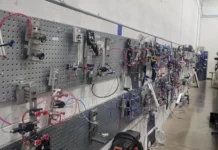by Dianna Brodine, managing editor
Plastics Business
Seven years ago, Rick Riesterer stood in front of an audience of his peers at a MAPP Benchmarking Conference and shared Plastic Components, Inc.’s best practices for program launches. Today, the best practices for the Germantown, Wisconsin, plastics molding company have a completely different starting point.
While the processes and procedures detailed on the production checklist are still critical, it’s the work that happens early in the development cycle that now is the focus. The emphasis is on working to understand the objectives of the customer and the component to “engineer” the desired outcome long before the production launch process begins.
Riesterer, PCI’s manager of business development, explained, “The complexity and component requirements, the materials selected and the assembly requirements continue to evolve. Our objective is to be involved as early in the development process as possible to avoid surprises later in the game. Our recent history shows that when there is a collaborative effort between all parties and a true understanding behind the science of tooling and molding each part and how it will affect the process, we have much better results and compressed timelines.”
Talent and technology
In November 2012, PCI opened the Engineering Resource Center (ERC), a prototype division that now has spun into an independently owned company located in a facility next door. The ERC and PCI work collaboratively with customers to design prototype tooling using science, technology, production-intent steels and gating schemes to learn as much as possible prior to the launch of a production tool.
PCI espouses a four-pronged approach to production launch: design for manufacturability/toolability; design for functionality; design for assembly and design for sustainability.
“Any one of these facets, if not addressed in full, can take the program timeline and throw a wrench into it,” Riesterer said, “and those missteps can cost weeks and thousands of dollars if not addressed up front. Very early on in the process, we engage the ERC, the production toolmaker of choice, the resin suppliers, hot manifold manufacturer and any other supplier with a product or service that will directly affect the outcome of the new component. We want them to understand the requirements of the customer, and we want to understand theirs. And, who better to ask about those requirements than the suppliers?”
PCI launches approximately 60 new production tools each year, and for each of those, the supplier partners are brought onsite during the development and/or sampling phase to make sure any potential issues are addressed.
“Historical data and expertise can tell us a lot. But, our focus is on the science of the entire process,” he said. “Materials are getting more complex, which means we now need an understanding of what a material may do long-term to a tool or a hot manifold system. Customers are asking for parts that are much more involved. The technology and equipment today is able to do more than ever before, and the only way to manage all of these factors is to understand the science and the physics behind each project. Our job is to make sure everyone is bringing their knowledge to the table.”
Relationships from the start
It isn’t always easy to convey the value of early involvement to the customer – until the customer can be shown proven results that have translated into faster times to market or reduced tooling costs. PCI strives to show its customers the value that could be missed if design, prototype and production are treated as separate processes, rather than integrated into one manufacturing chain. “We’re trying to change the trajectory of the conversation,” Riesterer explained. “We want to be involved early, from engineering and new product development through to the launch of production. Customers can be wary of that, until they are shown the value of the knowledge that could be incorporated from the beginning of the game.”
Pursuing customer prospects that already show an understanding of the necessity of technology, automation and science is an integral part of the relationship-laden progression that PCI wants to build. “If we target appropriately, most organizations understand the message we’re bringing to them,” he said. In addition, each new product launch is carefully managed by a team that includes an account manager, an engineer, a quality manager and a program manager. Those four staff members are responsible for the effective launch of a product and for ensuring the potential surprises that occur in almost every manufacturing start-up process are discovered before they happen.
“Of course, we have checklists,” Riesterer said. “The processes and procedures are important. But, if we don’t develop tooling from the very beginning with a clear understanding of the science and physics behind what we are doing and the customer’s objectives for the design, we are asking for a long road. The objective is to get products to market quickly, so let’s ‘engineer’ out the potential pitfalls first by involving all of the people involved who understand what could slow the process down.”



